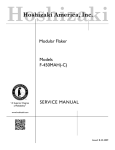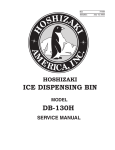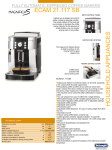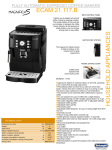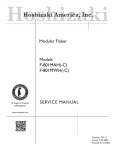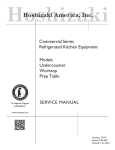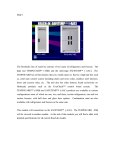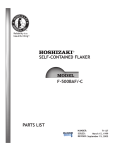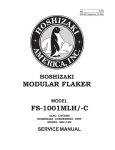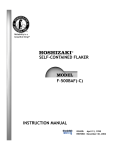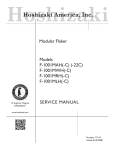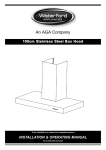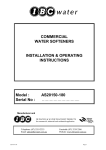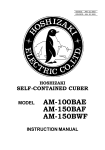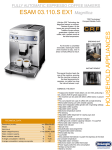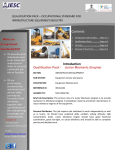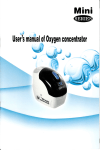Download F-500BAF/-C Service Manual
Transcript
Hoshizaki Hoshizaki America, Inc. Self-Contained Flaker Model F-500BAF “A Superior Degree of Reliability” SERVICE MANUAL www.hoshizaki.com Number: 73074 Issued: 3-2-1999 Revised: 12-26-2003 IMPORTANT Only qualified service technicians should attempt to service or maintain this icemaker. No service or maintenance should be undertaken until the technician has thoroughly read this Service Manual. HOSHIZAKI provides this manual primarily to assist qualified service technicians in the service and maintenance of the icemaker. Should the reader have any questions or concerns which have not been satisfactorily addressed, please call or write to the HOSHIZAKI Technical Support Department for assistance. HOSHIZAKI AMERICA, INC. 618 Highway 74 South Peachtree City, GA 30269 Attn: HOSHIZAKI Technical Support Department Phone: 1-800-233-1940 Technical Service (770) 487-2331 Fax: (770) 487-3360 Web Site: www.hoshizakiamerica.com Note: To expedite assistance, all correspondence/communication MUST include the following information: • Model Number • Serial Number • Complete and detailed explanation of the problem 2 Please review this manual. It should be read carefully before the icemaker is serviced or maintenance operations are performed. Only qualified service technicians should service and maintain the icemaker. This manual should be made available to the technician prior to service or maintenance. CONTENTS I. Specifications .................................................................................................................... 5 F-500BAF ........................................................................................................................ 5 F-500BAF-C ..................................................................................................................... 6 II. General Information .......................................................................................................... 7 1. Construction ................................................................................................................. 7 F-500BAF, F-500BAF-C ............................................................................................. 7 2. Ice Making Unit ............................................................................................................. 8 3. Control Box Layout ....................................................................................................... 9 F-500BAF, F-500BAF-C ............................................................................................. 9 4. Timer Board ................................................................................................................ 10 [a] Solid-State Control .............................................................................................. 10 [b] Timer Board ......................................................................................................... 10 [c] Sequence ............................................................................................................ 11 III. Technical Information ..................................................................................................... 14 1. Water Circuit and Refrigerant Circuit........................................................................... 14 F-500BAF, F-500BAF-C ........................................................................................... 14 2. Wiring Diagram ........................................................................................................... 15 F-500BAF, F-500BAF-C ........................................................................................... 15 3. Sequence of Electrical Circuit .................................................................................... 16 F-500BAF, F-500BAF-C ......................................................................................... 16 4. Timing Chart ............................................................................................................... 21 5. Performance Data ....................................................................................................... 24 F-500BAF ................................................................................................................ 24 F-500BAF-C ............................................................................................................. 25 IV. Service Diagnosis .......................................................................................................... 26 1. No Ice Production ....................................................................................................... 26 2. Low Ice Production ..................................................................................................... 29 3. Other ........................................................................................................................... 30 V. Removal and Replacement of Components .................................................................. 31 1. Service for Refrigerant Lines ...................................................................................... 31 [a] Refrigerant Recovery........................................................................................... 31 [b] Evacuation and Recharge [R-404A] .................................................................... 31 2. Brazing ....................................................................................................................... 32 3. Removal and Replacement of Compressor ................................................................ 33 4. Removal and Replacement of Drier ........................................................................... 34 5. Removal and Replacement of Expansion Valve ......................................................... 35 6. Removal and Replacement of Evaporator Assembly ................................................ 36 7. Removal and Replacement of Fan Motor ................................................................... 40 8. Removal and Replacement of Control Water Valve .................................................... 40 3 VI. Cleaning and Maintenance .......................................................................................... 41 1. Preparing the Icemaker for Long Storage ................................................................... 41 2. Cleaning and Sanitizing Instructions .......................................................................... 42 [a] Cleaning Solution ................................................................................................ 42 [b] Cleaning Procedure ............................................................................................ 42 [c] Sanitizing Solution ............................................................................................... 43 [d] Sanitizing Procedure - Initial ................................................................................ 44 [e] Sanitizing Procedure - Final ................................................................................ 44 3. Maintenance Instructions ............................................................................................ 46 4 I. Specifications F-500BAF AC S UP P LY VOLTAGE COMP RE S S OR GE AR MOTOR FAN MOTOR OTHE R MAXIMUM FUS E S IZE MAX. HACR BREAKER (USA ONLY) MAX. CIRC. BRE AKE R (CANADA ONLY) MINIMUM CIRCUIT AMP ACITY AP P ROXIMATE ICE P RODUCTION P E R 24 HR. lbs./day ( kg/day ) Reference without *marks S HAP E OF ICE ICE QUALITY AP P ROXIMATE S TORAGE CAP ACITY E LE CTRIC & W ATE R CONS UMP TION E LE CTRIC W (kW H/100 lbs.) P OTABLE W ATE R gal./24HR (gal./100 lbs.) E XTE RIOR DIME NS IONS (W xDxH) E XTE RIOR FINIS H W E IGHT CONNE CTIONS - E LE CTRIC - W ATE R S UP P LY - DRAIN ICE MAKING S YS TE M HARVE S TING S YS TE M ICE MAKING W ATE R CONTROL COOLING W ATE R CONTROL BIN CONTROL S YS TE M COMP RE S S OR CONDE NS E R E VAP ORATOR RE FRIGE RANT CONTROL RE FRIGE RANT CHARGE DE S IGN P RE S S URE P .C. BOARD CIRCUIT P ROTE CTION COMP RE S S OR P ROTE CTION GE AR MOTOR P ROTE CTION RE FRIGE RANT CIRCUIT P ROTE CTION LOW W ATE R P ROTE CTION ACCE S S ORIE S - S UP P LIE D - RE QUIRE D OP E RATING CONDITIONS DRAW ING NO. (DIME NS IONS ) 115/60/1 120 V 7.9 RLA 51 LRA 120 V 1.6 FLA 1/6 HP 120 V 0.85 FLA 1/15 HP 120 V 0.03 A 20 A 20 A 20 A 20 A Ambient W ATE R TE MP . (ーF) Temp.(ーF) 50 70 90 70 * 478 (217) 458 (208) 438 (199) 80 419 (190) 400 (182) 383 (174) 90 366 (166) * 359 (163) 335 (152) 100 320 (145) 306 (139) * 287 (130) Flake Approx. 70% , Ice (90/70ーF, Conductivity 200 オs/cm) 250 lbs. 90/70ーF 70/50ーF 900 (6.0) 854 (4.3) 43 (12) 57 (12) 38" x 29" x 36" (965 x 735 x 915 mm) P VC Coated Galvanized S teel; Galvanized S teel (Rear); S tainless S teel (Top) Net 210 lbs. ( 95 kg ), Shipping 245 lbs. ( 111 kg ) P ermanent Connection Inlet 1/2" FP T Drain P an 3/4" FP T Bin Drain 3/4" FP T Auger type Direct Driven Auger ( 1/6 HP Gear Motor ) Float S witch N/A Mechanical Bin Control ( P roximity S w. ) Hermetic, Model RS 43C1E -CAA Air-cooled, Fin and tube type Copper Tube on Cylinder Thermostatic E xpansion Valve R-404A, 1 lb. (470 g) High 460 P S IG, Low 290 P S IG High Voltage Cut-off Relay Auto-reset Overload P rotector Manual reset Circuit Breaker Auto-reset High P ressure Control S witch Float S witch and Timer Ice S coop, S pare Fuse Legs VOLTAGE RANGE 104 - 127 V AMBIE NT TE MP . 45 - 100ー F W ATE R S UP P LY TE MP . 45 - 90ー F W ATE R S UP P LY P RE S S URE 10 - 113 P S IG 339850--- We reserve the right to make changes in specifications and design without prior notice. 5 F-500BAF-C AC S UP P LY VOLTAGE COMP RE S S OR GE AR MOTOR FAN MOTOR OTHE R MAXIMUM FUS E S IZE MAX. HACR BREAKER (USA ONLY) MAX. CIRC. BRE AKE R (CANADA ONLY) MINIMUM CIRCUIT AMP ACITY AP P ROXIMATE ICE P RODUCTION P E R 24 HR. lbs./day ( kg/day ) Reference without *marks S HAP E OF ICE ICE QUALITY AP P ROXIMATE S TORAGE CAP ACITY E LE CTRIC & W ATE R CONS UMP TION E LE CTRIC W (kW H/100 lbs.) P OTABLE W ATE R gal./24HR (gal./100 lbs.) E XTE RIOR DIME NS IONS (W xDxH) E XTE RIOR FINIS H W E IGHT CONNE CTIONS - E LE CTRIC - W ATE R S UP P LY - DRAIN ICE MAKING S YS TE M HARVE S TING S YS TE M ICE MAKING W ATE R CONTROL COOLING W ATE R CONTROL BIN CONTROL S YS TE M COMP RE S S OR CONDE NS E R E VAP ORATOR RE FRIGE RANT CONTROL RE FRIGE RANT CHARGE DE S IGN P RE S S URE P .C. BOARD CIRCUIT P ROTE CTION COMP RE S S OR P ROTE CTION GE AR MOTOR P ROTE CTION RE FRIGE RANT CIRCUIT P ROTE CTION LOW W ATE R P ROTE CTION ACCE S S ORIE S - S UP P LIE D - RE QUIRE D OP E RATING CONDITIONS DRAW ING NO. (DIME NS IONS ) 115/60/1 120 V 7.9 RLA 51 LRA 120 V 1.6 FLA 1/6 HP 120 V 0.85 FLA 1/15 HP 120 V 0.03 A 20 A 20 A 20 A 20 A Ambient W ATE R TE MP . (ーF) Temp.(ーF) 50 70 90 70 * 431 (196) 415 (188) 398 (181) 80 381 (173) 365 (166) 350 (159) 90 336 (152) * 333 (151) 308 (140) 100 295 (134) 283 (128) * 263 (119) Cubelet Approx. 80% , Ice (90/70ーF, Conductivity 200 オs/cm) 250 lbs. 90/70ーF 70/50ーF 903 (6.5) 864 (4.8) 40 (12) 52 (12) 38" x 29" x 36" (965 x 735 x 915 mm) P VC Coated Galvanized S teel; Galvanized S teel (Rear); S tainless S teel (Top) Net 210 lbs. ( 95 kg ), Shipping 245 lbs. ( 111 kg ) P ermanent Connection Inlet 1/2" FP T Drain P an 3/4" FP T Bin Drain 3/4" FP T Auger type Direct Driven Auger ( 1/6 HP Gear Motor ) Float S witch N/A Mechanical Bin Control ( P roximity S w. ) Hermetic, Model RS 43C1E -CAA Air-cooled, Fin and tube type Copper Tube on Cylinder Thermostatic E xpansion Valve R-404A, 1 lb. (470 g) High 460 P S IG, Low 290 P S IG High Voltage Cut-off Relay Auto-reset Overload P rotector Manual reset Circuit Breaker Auto-reset High P ressure Control S witch Float S witch and Timer Ice S coop, S pare Fuse Legs VOLTAGE RANGE 104 - 127 V AMBIE NT TE MP . 45 - 100ー F W ATE R S UP P LY TE MP . 45 - 90ー F W ATE R S UP P LY P RE S S URE 10 - 113 P S IG 339850--- We reserve the right to make changes in specifications and design without prior notice. 6 II. General Information 1. Construction F-500BAF, F-500BAF-C Top Panel Side Panel Side Panel Sliding Door Water Supply Inlet Front Panel Control Water Valve Spout Reservoir Gear Motor Evaporator Access Valve Condenser Compressor Condenser Fan Control Box 7 2. Ice Making Unit 8 3. Control Box Layout F-500BAF, F-500BAF-C PRESSURE SWITCH CONNECTOR TRANSFORMER CONTROL TIMER FLUSH VALVE CONTROL RELAY FLUSH STARTER FLUSH SWITCH ICE ON POWER SWITCH RUN CAPACITOR OFF FUSE CIRCUIT PROTECT RELAY CIRCUIT BREAKER START CAPACITOR GEAR MOTOR PROTECT RELAY CAPACITOR FOR GEAR MOTOR CAPACITOR FOR FAN MOTOR WATER CONTROL RELAY Note: The above component names are identical with the wiring label, but not with the parts list. 9 4. Timer Board [a] Solid-State Control 1) A HOSHIZAKI exclusive solid-state control is employed in the self-contained flaker icemakers. 2) A printed circuit board (hereafter called “timer board”) includes a stable and high quality control system. 3) All models are pre-tested and factory adjusted. [b] Timer Board CAUTION 1. Fragile, handle very carefully. 2. A timer board contains CMOS (Complementary Metal-Oxide Semiconductor) integrated circuits, which are susceptible to failure due to static discharge. It is especially important to use an anti-static wrist strap when handling or replacing the board. 3. Do not touch the electronic devices on the board or the back of the board to prevent damage to the board. 4. Do not change wiring and connections. Especially, never misconnect terminals. 5. Do not fix the electronic devices or parts on the board in the field. Always replace the whole board assembly when it goes bad. The icemaker is controlled by the timer board for the following purposes: 1) To prevent the gear motor and the compressor from starting or stopping simultaneously. 2) To reduce remaining ice in the refrigeration casing. 3) To protect the unit in case of low water and low water pressure. 4) To protect the unit in case the bin control causes chattering. 10 Compressor Relay Gear Motor Relay Fig. 1 [c] Sequence Fig. 2 11 PART CODE MODEL RATING T1 T2 T3 T4 T5 T6 437305-01 H2AA144C01 24 VAC 50/60Hz 60±15 sec. 90±22 sec. 150±45 sec. 1 sec. or less 6.7 sec. ± 70% 6.7 sec. ± 70% Fig. 3 12 Functions of Terminals 1) Terminals 1, 2 Power supply AC 24V. 2) Terminals 3, 4 Control X1 (GM) and X2 (CM) Relays. When closed, energize X1 (GM) in 1 sec. and X2 (CM) in 60 sec. When opened, de-energize X1 (GM) in 150 sec. and X2 (CM) in 90 sec. 3) Terminals 5, 6 Control X1 (GM) and X2 (CM) Relays. When opened, de-energize X1 (GM) and X2 (CM) immediately. When closed again, energize X1 (GM) in 1 sec. and X2 (CM) in 60 sec. 4) Terminals 7, 8, 9 X1 (GM) contacts. 8 is a movable contact, 7 is a make contact, and 9 is a break contact. 5) Terminals 10, 11 Control X2 (CM) Relays. When opened, de-energize X2 (CM) immediately. When closed, energize X2 (CM) immediately. Note: 1. X2 Relay is a single pole, normally open relay, and its terminals are mounted on the relay itself. 2. The above operation times are median. See Fig. 3 for details. 13 III. Technical Information 1. Water Circuit and Refrigerant Circuit F-500BAF, F-500BAF-C CONTROL WATER VALVE SPOUT FLOAT SWITCH WATER INLET WATER LEVEL EVAPORATOR RESERVOIR EXPANSION VALVE OVERFLOW GEAR MOTOR FLUSH WATER VALVE DRAIN PAN DRAIN OUTLET DRAIN PAN DRIER CONDENSER CONDENSER FAN MOTOR PRESSURE SWITCH ACCESS VALVE COMPRESSOR WATER CIRCUIT REFRIGERANT CIRCUIT 14 ACCESS VALVE 2. Wiring Diagram F-500BAF, F-500BAF-C 15 3. Sequence of Electrical Circuit F-500BAF, F-500BAF-C [a] When power switch is moved to "ON" position and flush switch to "ICE" position, water starts to be supplied to reservoir. 115-120/60/1 L N KC1 KC4 8 7 KC3 KC6 BR 5 O RUN CAP. 3 CONTROL SWITCH 1 V CIRCUIT PROTECT RELAY (X5) MOT. PROTECTOR 3 1 KA9 C S KA1 15MFD STARTER 5 2 COMP. KA3 DBU 1 START CAP. 270-324MFD W BK R R O GEAR MOTOR PROTECT RELAY (X4) K CIRCUIT SWITCH 3 4 5 6 7 8 (Y) (DBU) CONDENSER FAN MOTOR KB6 (BR) P KA2 (BR) (W) DBU CAP. KA8 10MFD (O) BK GY PRESSURE SWITCH 2 GEAR MOTOR THERMAL PROTECTOR KA5 6 A 1 LBU KA7 V CAP. 2.5MFD KA4 (BK) O O W (O) TRANS. KB2 9 (BK) 1 FLUSH WATER VALVE LBU LBU 4 6 5 BK V P BR 3 R 10 11 GY O CONTROL WATER VALVE 1 2 3 KB1 FLUSH RELAY (X6) P K 3 BR W BK R O GY P DBU V Y LBU BU 1 4 K 3 D R 2 4 CONTROL TIMER KD2 5 R 7 8 BK 24V FUSE (1A) R WIRE COLOR CODE 4 D FLUSH SWITCH P BIN CONTROL SWITCH LBU 3 5 7 2 4 6 8 BR DBU O BK WATER CONTROL RELAY (X3) O (F-500BAF(-C)) 16 KD1 KB4 K (BU) 3 B (O) KB5 (BK) FLOAT SWITCH BROWN WHITE BLACK RED ORANGE GRAY PINK DARK BLUE VIOLET YELLOW LIGHT BLUE BLUE [b] When reservoir has been filled up, gear motor starts immediately. 115-120/60/1 L N KC1 KC4 8 7 KC3 KC6 W BR 5 CONTROL SWITCH 1 CIRCUIT PROTECT RELAY (X5) O RUN CAP. 3 V MOT. PROTECTOR 3 1 KA9 C S KA1 15MFD STARTER 5 2 COMP. KA3 DBU 1 START CAP. 270-324MFD BK R R O GEAR MOTOR PROTECT RELAY (X4) KA6 CIRCUIT SWITCH 3 4 5 6 7 8 (Y) (DBU) CONDENSER FAN MOTOR KB6 (BR) P KA2 (BR) (W) DBU LBU CAP. 10MFD KA8 (O) BK GY PRESSURE SWITCH 2 GEAR MOTOR THERMAL PROTECTOR KA5 1 KA7 V CAP. 2.5MFD KA4 (BK) O O W (O) TRANS. 9 (BK) BK 24V KB2 1 FLUSH WATER VALVE LBU LBU 3 4 P BK V BR 3 6 5 BR W BK R O GY P DBU V Y LBU BU R 10 11 GY O CONTROL WATER VALVE 1 1 4 2 3 KB1 FLUSH RELAY (X6) P KD3 R 2 4 CONTROL TIMER KD2 5 R 7 8 FUSE (1A) R WIRE COLOR CODE KD4 FLUSH SWITCH P BIN CONTROL SWITCH LBU 3 2 4 5 6 7 8 BR DBU O BK WATER CONTROL RELAY (X3) O (F-500BAF(-C)) 17 KD1 KB4 K (BU) 3 B (O) KB5 (BK) FLOAT SWITCH BROWN WHITE BLACK RED ORANGE GRAY PINK DARK BLUE VIOLET YELLOW LIGHT BLUE BLUE [c] Compressor starts about 60 sec. after gear motor starts. 115-120/60/1 L N KC1 KC4 8 7 KC3 KC6 W BR 5 CONTROL SWITCH 1 CIRCUIT PROTECT RELAY (X5) O RUN CAP. 3 V MOT. PROTECTOR 3 1 KA9 C S KA1 15MFD STARTER 5 2 COMP. KA3 DBU 1 START CAP. 270-324MFD BK R R O GEAR MOTOR PROTECT RELAY (X4) KA6 CIRCUIT SWITCH 3 4 5 6 7 8 (Y) K (BR) (W) DBU LBU V CAP. 2.5MFD 6 B (BR) P KA2 KA7 (DBU) CONDENSER FAN MOTOR CAP. 10MFD KA8 (O) BK GY PRESSURE SWITCH 2 GEAR MOTOR THERMAL PROTECTOR KA5 1 KA4 (BK) O O W (O) TRANS. KB2 9 (BK) 1 FLUSH WATER VALVE LBU LBU 3 4 BK V BR 3 6 5 R 10 P BR W BK R O GY P DBU V Y LBU BU 11 GY O CONTROL WATER VALVE 1 1 4 2 3 KB1 FLUSH RELAY (X6) P KD3 R 2 4 CONTROL TIMER KD2 5 R 7 8 BK 24V FUSE (1A) R WIRE COLOR CODE KD4 FLUSH SWITCH P BIN CONTROL SWITCH LBU 3 2 4 5 6 7 8 BR DBU O BK WATER CONTROL RELAY (X3) O (F-500BAF(-C)) 18 KD1 KB4 K (BU) 3 B (O) KB5 (BK) FLOAT SWITCH BROWN WHITE BLACK RED ORANGE GRAY PINK DARK BLUE VIOLET YELLOW LIGHT BLUE BLUE [d] Compressor stops about 90 sec. after bin control operates. Gear motor stops about 60 sec. later, and water is drained from the water circuit. Water can be also drained by moving flush switch to "FLUSH" position. 115-120/60/1 L N KC1 KC4 8 7 KC3 KC6 W BR 5 CONTROL SWITCH 1 CIRCUIT PROTECT RELAY (X5) O RUN CAP. 3 V MOT. PROTECTOR 3 1 KA9 C S KA1 15MFD STARTER 5 2 COMP. KA3 DBU 1 START CAP. 270-324MFD BK R R O GEAR MOTOR PROTECT RELAY (X4) KA6 CIRCUIT SWITCH 3 4 5 6 7 8 (Y) K (BR) (W) DBU LBU V CAP. 2.5MFD 6 B (BR) P KA2 KA7 (DBU) CONDENSER FAN MOTOR CAP. 10MFD KA8 (O) BK GY PRESSURE SWITCH 2 GEAR MOTOR THERMAL PROTECTOR KA5 1 KA4 (BK) O O W (O) TRANS. KB2 7 8 9 (BK) BK 24V FUSE (1A) R WIRE COLOR CODE 1 FLUSH WATER VALVE LBU LBU R 2 3 4 BK V 2 11 GY O CONTROL WATER VALVE 3 KB1 FLUSH RELAY (X6) P KD4 FLUSH SWITCH P BIN CONTROL SWITCH O P 1 3 KD3 R 10 1 4 R BR 3 6 5 KD2 5 4 CONTROL TIMER BR W BK R O GY P DBU V Y LBU BU LBU 2 4 5 6 7 8 BR DBU O BK WATER CONTROL RELAY (X3) (F-500BAF(-C)) 19 KD1 KB4 K (BU) 3 B (O) KB5 (BK) FLOAT SWITCH BROWN WHITE BLACK RED ORANGE GRAY PINK DARK BLUE VIOLET YELLOW LIGHT BLUE BLUE [e] When 208 - 230V are supplied to the power supply due to miswiring, circuit protect relay operates, and the icemaker does not run. 115-120/60/1 L N KC1 KC4 8 7 KC3 KC6 W BR 5 CONTROL SWITCH 1 CIRCUIT PROTECT RELAY (X5) O RUN CAP. 3 K 15MFD V MOT. PROTECTOR 3 1 KA9 C S 1 A STARTER 5 2 COMP. KA3 DBU 1 START CAP. 270-324MFD BK R R O GEAR MOTOR PROTECT RELAY (X4) K CIRCUIT SWITCH 3 4 5 6 7 8 (Y) (BR) (W) DBU LBU V CAP. 2.5MFD KB6 (BR) P KA2 KA7 (DBU) CONDENSER FAN MOTOR CAP. 10MFD KA8 (O) BK GY PRESSURE SWITCH 2 GEAR MOTOR THERMAL PROTECTOR KA5 6 A 1 KA4 (BK) O O W (O) TRANS. 9 (BK) BK 24V KB2 1 FLUSH WATER VALVE LBU LBU 3 4 BK V BR 3 6 5 R 10 P BR W BK R O GY P DBU V Y LBU BU 11 GY O CONTROL WATER VALVE 1 1 4 2 3 KB1 FLUSH RELAY (X6) P KD3 R 2 4 CONTROL TIMER KD2 5 R 7 8 FUSE (1A) R WIRE COLOR CODE KD4 FLUSH SWITCH P BIN CONTROL SWITCH LBU 3 5 7 2 4 6 8 BR DBU O BK WATER CONTROL RELAY (X3) O (F-500BAF(-C)) 20 KD1 KB4 K (BU) 3 B (O) KB5 (BK) FLOAT SWITCH BROWN WHITE BLACK RED ORANGE GRAY PINK DARK BLUE VIOLET YELLOW LIGHT BLUE BLUE Miswiring. Circuit Protect Relay operates. Proper wiring. The unit starts. BIN CONTROL 4. Timing Chart OFF 1. CIRCUIT PROTECT RELAY ON ON OFF UPPER 2. WATER LEVEL LOWER BOTTOM UPPER 3. FLOAT SWITCH LOWER 4. WATER CONTROL RELAY 5. CONTROL WATER VALVE 6. FLUSH RELAY ON OFF ON OFF ON OFF ON OFF ON OFF FLUSH 7. FLUSH SWITCH 8. FLUSH WATER VALVE 9. BIN CONTROL ICE ON OFF ON OFF 1 sec 10. GEAR MOTOR RELAY 11. GEAR MOTOR 12. FAN MOTOR 150 sec ON OFF ON OFF ON OFF 60 sec 13. COMPRESSOR ON OFF 14. PRESSURE ON SWITCH OFF 21 90 sec CONDENSER FAN FAILURE LOW WATER 1. CIRCUIT PROTECT RELAY ON OFF UPPER 2. WATER LEVEL LOWER BOTTOM UPPER 3. FLOAT SWITCH LOWER 4. WATER CONTROL RELAY 5. CONTROL WATER VALVE ON OFF ON OFF ON OFF ON OFF ON 6. FLUSH RELAY OFF FLUSH 7. FLUSH SWITCH 8. FLUSH WATER VALVE 9. BIN CONTROL ICE ON OFF ON OFF 150 sec 10. GEAR MOTOR RELAY 11. GEAR MOTOR 12. FAN MOTOR 1 sec ON OFF ON OFF ON OFF 90 sec 13. COMPRESSOR 60 sec ON OFF 14. PRESSURE ON SWITCH OFF 22 FLUSH SWITCH FLUSH 1. CIRCUIT PROTECT RELAY ICE ON OFF UPPER 2. WATER LEVEL UPPER 3. FLOAT SWITCH LOWER 4. WATER CONTROL RELAY 5. CONTROL WATER VALVE LOWER BOTTOM ON OFF ON OFF ON OFF ON OFF ON 6. FLUSH RELAY 7. FLUSH SWITCH 8. FLUSH WATER VALVE 9. BIN CONTROL OFF FLUSH ICE ON OFF ON OFF 150 sec 10. GEAR MOTOR RELAY 11. GEAR MOTOR 1 sec ON OFF ON OFF 60 sec 12. FAN MOTOR ON OFF 90 sec 13. COMPRESSOR ON OFF 14. PRESSURE ON SWITCH OFF 23 5. Performance Data F-500BAF APPROXIMATE ICE PRODUCTION PER 24 HR. lbs./day (kg/day) APPROXIMATE ELECTRIC CONSUMPTION watts APPROXIMATE WATER CONSUMPTION PER 24 HR. gal./day (l/day) EVAPORATOR OUTLET TEMP. °F (°C) HEAD PRESSURE PSIG (kg/cm²G) SUCTION PRESSURE PSIG ( kg/cm²G ) TOTAL HEAT OF REJECTION Ambient Temp. (°F) 70 80 90 100 70 80 90 100 70 80 90 100 70 80 90 100 70 80 90 100 70 80 90 100 Water Temp. 50 70 *478 *(217) 458 (208) 419 (190) 400 (182) 366 (166) *359 *(163) 320 (145) 306 (139) *854 -861 -874 -880 -893 -*900 -915 -923 -*57 *(217) 55 (208) 50 (190) 48 (182) 44 (166) *43 *(163) 38 (145) 37 (139) *8 *(-13) 8 (-13) 8 (-13) 12 (-11) 12 (-11) *11 *(-11) 15 (-9) 15 (-9) *221 *(15.5) 221 (15.6) 253 (17.8) 253 (17.8) 285 (20) *285 *(20) 327 (23) 327 (23) *26 *(1.8) 26 (1.8) 28 (2.0) 28 (2.0) 31 (2.1) *31 *(2.0) 34 (2.4) 34 (2.4) 4683 BTU/h (AT 90°F /WT 70°F) (°F) 90 438 383 335 *287 867 887 908 *930 53 46 40 *34 8 12 15 *15 221 253 285 *327 26 28 31 *34 Note: The data without *marks should be used for reference. We reserve the right to make changes in specifications and design without prior notice. 24 (199) (174) (152) *(130) ----(199) (174) (152) *(129) (-13) (-11) (-9) *(-9) (15.5) (17.8) (20) *(23) (1.8) (2.0) (2.1) *(2.4) F-500BAF-C APPROXIMATE ICE PRODUCTION PER 24 HR. lbs./day (kg/day) APPROXIMATE ELECTRIC CONSUMPTION watts APPROXIMATE WATER CONSUMPTION PER 24 HR. gal./day (l/day) EVAPORATOR OUTLET TEMP. °F (°C) HEAD PRESSURE PSIG (kg/cm²G) SUCTION PRESSURE PSIG ( kg/cm²G ) TOTAL HEAT OF REJECTION Ambient Temp. (°F) 70 80 90 100 70 80 90 100 70 80 90 100 70 80 90 100 70 80 90 100 70 80 90 100 Water Temp. 50 70 *431 *(196) 415 (188) 381 (173) 365 (166) 336 (152) *333 *(151) 295 (134) 283 (128) *864 -869 -880 -886 -897 -*902 -912 -917 -*52 *(196) 50 (188) 46 (173) 44 (166) 40 (152) *40 *(151) 35 (134) 34 (128) *9 *(-13) 9 (-13) 9 (-13) 12 (-11) 12 (-11) *12 *(-11) 15 (-9) 15 (-9) *225 *(15.8) 225 (15.8) 258 (18.1) 258 (18.1) 292 (20.5) *292 *(20.5) 332 (23.3) 332 (23.3) *27 *(1.9) 27 (1.9) 30 (2.1) 30 (2.1) 32 (2.3) *32 *(2.3) 35 (2.5) 35 (2.5) 4724 BTU/h (AT 90°F /WT 70°F) (°F) 90 398 350 308 *263 875 891 907 *922 48 42 37 *32 9 12 15 *15 225 258 292 *332 27 30 32 *35 Note: The data without *marks should be used for reference. We reserve the right to make changes in specifications and design without prior notice. 25 (181) (159) (140) *(119) ----(181) (159) (140) *(119) (-13) (-11) (-9) *(-9) (15.8) (18.1) (20.5) *(23.3) (1.9) (2.1) (2.3) *(2.5) IV. Service Diagnosis 1. No Ice Production PROBLEM [1] The icemaker will not start. [2] Water does not stop, and the icemaker will not start POSSIBLE CAUSE a) Power Supply 1. 2. 3. b) Power Switch (Control Box) 4. Blown fuse. 1. Off position. 2. Bad contacts. 4. 1. 2. c) Fuse (Control Box) 1. Blown out. 1. d) Circuit Protect Relay 1. Miswiring. 1. e) Flush Switch 1. FLUSH position. 2. Bad contacts. 1. 2. f) Transformer g) Control Water Valve h) Shut-off Valve 1. 1. 1. 2. Coil winding opened. Coil winding opened. Closed. Water failure. 1. 1. 1. 2. i) 1. Disconnected. 2. Terminal out of Plug or Receptacle. 1. Contact fused. 2. Coil winding opened. 1. Bad contacts. 1. 2. 2. 1. Clean or replace d) Hoses a) Water Control Relay 2. Float does not move freely. 1. Valve seat clogged and water leaking. 1. Disconnected. 1. Bad contacts. Move to ON position. Tighten. Check for continuity and replace. Replace. Move to ON position. Check for continuity and replace. Check for short circuit and replace. Check power supply voltage and wire properly. Move to ICE position. Check for continuity and replace. Replace. Replace. Open. Wait till water is supplied. Connect. Insert terminal back in position Replace. Replace. Check for continuity and replace. Clean or replace. 1. b) Bin Control 1. Bad contacts. Connect. Check for continuity and replace. Check for continuity and replace. Clean axle and its corresponding holes or replace Bin Control. Find out the cause, get rid of it, and press Reset Button on Circuit Breaker. Plug and Receptacle (Control Box) a) Water Control Relay b) Float Switch c) Flush Water Valve [3] Water has been supplied, but the icemaker will not start. REMEDY 1. OFF position. 2. Loose connection. 3. Bad contacts. 1. 2. 1. 2. Activator does not move freely. c) Gear Motor Protector (Circuit Breaker) 1. Tripped. 26 1. PROBLEM POSSIBLE CAUSE d) Gear Motor Protect Relay [4] Gear Motor starts, but Compressor will not start or operates intermittently REMEDY 1. Coil winding opened. 1. Replace. 2. Bad contacts. 2. Check for continuity and replace. 1. Broken. 1. Replace. e) Control Timer (Printed Circuit Board) a) Pressure Switch 1. Dirty Air Filter or 1. Clean. Condenser. 2. Ambient temperature 2. Get cooler. too warm. 3. Fan not rotating. 4. Refrigerant overcharged. 5. Refrigerant line or components plugged. 6. Bad contacts. b) X2 Relay on Control Timer 7. 1. 2. 1. c) Starter 2. 3. 1. d) Start Capacitor or Run Capacitor 27 3. See "3. [1] a) Fan Motor." 4. Recharge. 5. Clean and replace drier. 6. Check for continuity and replace. Loose connections. 7. Tighten. Bad contacts. 1. Check for continuity and replace. Coil winding opened. 2. Replace Timer. Bad contacts. 1. Check for continuity and replace. Coil winding opened. 2. Replace. Loose Connections. 3. Tighten. Defective. 1. Replace. PROBLEM POSSIBLE CAUSE e) Compressor 3. Motor Protector tripped. f) [5] Gear Motor and Compressor start but no ice is produced. Power Supply a) Refrigerant Line REMEDY 1. Loose connections. 1. Tighten. 2. Motor winding 2. Replace. opened or grounded. 1. Circuit Ampacity too low. 1. Gas leaks. 2. Refrigerant line clogged. 28 3. Find out the cause of overheat or overcurrent. 1. Install a larger-sized conductor. 1. Check for leaks with a leak detector. Reweld leak, replace drier and charge with refrigerant. The amount of refrigerant is marked on Nameplate or Label. 2. Replace the clogged component. 2. Low Ice Production PROBLEM [1] Low ice production POSSIBLE CAUSE a) Refrigerant Line 1. Gas leaks. REMEDY 1. See "1. [5] a) Refrigerant Line." 2. Replace the clogged component. 3. Recharge. 1. Clean. 2. Refrigerant line clogged. 3. Overcharged. 1. Dirty Air Filter or Condenser. 2. Ambient temperature 2. Get cooler. too warm. b) High-side Pressure Too High 3. Fan rotating too slow. 1. Low-side pressure too low. 2. Low-side pressure too high. c) Expansion Valve (not adjustable) 29 3. See "3 [1] a) Fan Motor." 1. Replace. 2. See if Expansion Valve Bulb is mounted properly, and replace the valve if necessary. 3. Other PROBLEM [1] Abnormal noise POSSIBLE CAUSE a) Fan Motor b) Compressor c) Refrigerant Lines d) Gear Motor (Ice Making) e) Evaporator 1. Bearing worn out. 2. Fan blade deformed. 3. Fan blade does not move freely. 1. Bearings worn out, or cylinder valve broken. 2. Mounting pad out of position. 1. Rub or touch lines or other surfaces. 1. Bearing or Gear worn out / damaged. 1. Low-side pressure too low. 2. [2] Overflow from Reservoir (Water does not stop.) [3] Gear Motor Fuse blows or Circuit Breaker trips frequently. a) Water Supply 1. b) Control Water Valve 1. c) Float Switch 1. a) Power Supply Voltage 1. b) Evaporator Assy 1. c) Bin Control 1. 2. 30 REMEDY 1. Replace. 2. Replace fan blade. 3. Replace. 1. Replace. 2. Reinstall. 1. Replace. 1. Replace. 1. See if Expansion Valve Bulb is mounted properly, and replace the valve if necessary. Scale on inside wall 2. Remove Auger. Use of Freezing Cylinder. "SCALE AWAY" or "LIME-A-WAY" solution to clean periodically. If the water is found hard by testing, install a softener. Water pressure too 1. Install a pressure high. Reducing Valve Diaphragm does not 1. Clean or replace. close. Bad contacts. 1. Check for continuity and replace. Too high or too low. 1. Connect the unit to a power supply of proper voltage. Bearings or Auger 1. Replace Bearing or worn out. Auger. Bad contacts. 1. Check for continuity and replace. Activator does not 2. Clean Axle and its move freely. corresponding holes or replace Bin Control. V. Removal and Replacement of Components IMPORTANT Ensure all components, fasteners and thumbscrews are securely in place after the equipment is serviced. IMPORTANT 1. The Polyol Ester (POE) oils used in R-404A units can absorb moisture quickly. Therefore it is important to prevent moisture from entering the system when replacing or servicing parts. 2. Always install a new filter drier every time the sealed refrigeration system is opened. 3. Do not leave the system open for longer than 15 minutes when replacing or servicing parts. 1. Service for Refrigerant Lines [a] Refrigerant Recovery The icemaker unit is provided with two refrigerant access valves - one on the low-side and one on the high-side line. Using proper refrigerant practices recover the refrigerant from the access valves and store it in an approved container. Do not discharge the refrigerant into the atmosphere. [b] Evacuation and Recharge [R-404A] 1) Attach charging hoses, a service manifold and a vacuum pump to the system. Be sure to connect charging hoses to both high-side and low-side access valves. IMPORTANT The vacuum level and vacuum pump may be the same as those for current refrigerants. However, the rubber hose and gauge manifold to be used for evacuation and refrigerant charge should be exclusively for POE oils. 2) Turn on the vacuum pump. Never allow the oil in the vacuum pump to flow backward. 3) Allow the vacuum pump to pull down to a 29.9" Hg vacuum. Evacuating period depends on pump capacity. 4) Close the low-side valve and high-side valve on the service manifold. 31 5) Disconnect the vacuum pump, and attach a refrigerant service cylinder to the highside line. Remember to loosen the connection, and purge the air from the hose. See the nameplate for the required refrigerant charge. Hoshizaki recommends only virgin refrigerant or reclaimed refrigerant which meets ARI Standard No. 700-88 be used. 6) A liquid charge is recommended for charging an R-404A system. Invert the service cylinder. Open the high-side, service manifold valve. 7) Allow the system to charge with liquid until the pressures balance. 8) If necessary, add any remaining charge to the system through the low-side. Use a throttling valve or liquid dispensing device to add the remaining liquid charge through the low-side access port with the unit running. 9) Close the two refrigerant access valves, and disconnect the hoses and service manifold. 10) Cap the access valves to prevent a possible leak. 2. Brazing WARNING 1. Refrigerant R-404A itself is not flammable at atmospheric pressure and temperatures up to 176°F. 2. Refrigerant R-404A itself is not explosive or poisonous. However, when exposed to high temperatures (open flames) R-404A can be decomposed to form hydrofluoric acid and carbonyl fluoride both of which are hazardous. 3. Always recover the refrigerant and store it in an approved container. Do not discharge the refrigerant into the atmosphere. 4. Do not use silver alloy or copper alloy containing arsenic. 5. Do not use R-404A as a mixture with pressurized air for leak testing. Refrigerant leaks can be detected by charging the unit with a little refrigerant, raising the pressure with nitrogen and using an electronic leak detector. Note: All brazing-connections are clear-paint coated. Sandpaper the brazingconnections before unbrazing the components. Use a good abrasive cloth to remove coating. 32 3. Removal and Replacement of Compressor IMPORTANT Always install a new drier every time the sealed refrigeration system is opened. Do not replace the drier until after all other repair or replacement has been made. 1) Unplug the icemaker. 2) Remove the panels. 2) Remove the terminal cover on the compressor, and disconnect the compressor wiring. 3) Recover the refrigerant and store it in an approved container, if required by an applicable law. 4) Remove the discharge, suction, and access pipes from the compressor using brazing equipment. WARNING When repairing a refrigerant system, be careful not to let the burner flame contact any electrical wires or insulation. 5) Remove the bolts and rubber grommets. 6) Slide and remove the compressor. Unpack the new compressor package. Install the new compressor. 7) Attach the rubber grommets of the prior compressor. 8) Sandpaper the discharge, suction and access pipes. 9) Place the compressor in position, and secure it using the bolts. 10) Remove plugs from the discharge, suction and access pipes. 11) Braze the access, suction and discharge lines (Do not change this order), while purging with nitrogen gas flowing at the pressure of 3-4 PSIG. 12) Install the new drier. 33 13) Check for leaks using nitrogen gas (140 PSIG) and soap bubbles. 14) Evacuate the system, and charge it with refrigerant. See the nameplate for the required refrigerant charge and type. 15) Connect the terminals to the compressor, and replace the terminal cover in its correct position. 16) Replace the panels in their correct position. 17) Plug in the icemaker. 4. Removal and Replacement of Drier IMPORTANT Always install a new drier every time the sealed refrigeration system is opened. Do not replace the drier until after all other repair or replacement has been made. 1) Unplug the icemaker. 2) Remove the panels. 3) Recover the refrigerant and store it in an approved container, if required by an applicable law. 4) Remove the drier using brazing equipment. 5) Install the new drier with the arrow on the drier in the direction of the refrigerant flow. Use nitrogen gas at the pressure of 3-4 PSIG when brazing the tubings. 6) Check for leaks using nitrogen gas (140 PSIG) and soap bubbles. 7) Evacuate the system, and charge it with refrigerant. See the nameplate for the required refrigerant charge and type. 8) Replace the panels in their correct position. 9) Plug in the icemaker. 34 5. Removal and Replacement of Expansion Valve IMPORTANT Sometimes moisture in the refrigerant circuit exceeds the drier capacity and freezes up at the expansion valve. Always install a new drier every time the sealed refrigeration system is opened. Do not replace the drier until after all other repairs or replacement have been made. 1) Unplug the icemaker. 2) Remove the panels. 3) Recover the refrigerant and store it in an approved container, if required by an applicable law. 4) Remove the expansion valve bulb at the evaporator outlet. 5) Remove the expansion valve cover, and remove the expansion valve using brazing equipment. 6) Braze the new expansion valve with nitrogen gas flowing at the pressure of 3-4 PSIG. WARNING Always protect the valve body by using a damp cloth to prevent the valve from overheating. Do not braze with the valve body exceeding 250°F. 7) Install the new drier. 8) Check for leaks using nitrogen gas (140 PSIG) and soap bubbles. 9) Evacuate the system. Charge it with refrigerant. See the nameplate for the required refrigerant charge and type. 10) Attach the bulb to the suction line. Be sure to secure the bulb using a band and to insulate it. 11) Place the expansion valve cover in position. 12) Replace the panels in their correct position. 13) Plug in the icemaker. 35 6. Removal and Replacement of Evaporator Assembly 1) Drain the water from the evaporator by switching the flush switch to “FLUSH” on the control box. 2) Unplug the icemaker. 3) Remove the panels. 4) Remove the three thumbscrews and take off the spout from the evaporator. Cutter 5) Loosen the cutter by a wrench and remove it. 6) Remove the cylinder gasket at the top of the evaporator. Extruding Head 7) Grasp the top of the auger and move the auger towards you and then try to insert a .02" round stock or pin gauge in between the back side of the auger shaft and the bearing surface. Check several locations around the auger shaft. If the gauge goes between the shaft and the bearing at any point, both the top bearing in the extruding head and the lower bearing in the housing should be replaced. Instructions for removing the housing are located later in this procedure. .02” Round Stock or Pin Gauge Auger Extruding Head Note: Replacing the bearing requires a bearing press adaptor. If one is not available, replace the whole extruding head and housing. 8) Remove the three socket head cap screws and lift off the extruding head. Auger 9) Lift out the auger. If the area in contact with the bearing is worn or the blade is scratched, replace the auger. 36 Evaporator Note: Skip the following steps 10) through 12) when the evaporator does not need replacement. 10) Recover the refrigerant and store it in an approved container, if required by an applicable law. IMPORTANT Always install a new drier every time the sealed refrigeration system is opened. Do not replace the drier until after all other repair or replacement has been made. 11) Remove the bulb of the expansion valve. 12) Disconnect the brazing-connections of the expansion valve and the copper tubelow side from the evaporator, using brazing equipment. 13) Remove the two truss head machine screws and the bracket securing the evaporator. 14) Disconnect the three hoses from the evaporator. 15) Remove the four socket head cap screws securing the evaporator with the bearinglower. 16) Lift off the evaporator. Housing, Lower Bearing and Mechanical Seal 17) The mechanical seal consists of two parts. One moves along with the auger, and the other is fixed on the housing. If the contact surfaces of these two parts are worn or scratched, the mechanical seal may cause water leaks and should be replaced. 18) Remove the O-ring from the housing. 19) Remove the four bolts and the housing from the gear motor. If inspection of the bearing inside the extruding head (earlier in this procedure) indicated that it is out of tolerance, replace both it and the bearing inside the housing. Note: Replacing the bearing requires a bearing press adaptor. If one is not available, replace the whole extruding head and housing. 37 Gear Motor 20) Remove the coupling-spline on the gear motor shaft. 21) Remove the three bolts securing the gear motor. 22) Assemble the removed parts in the reverse order of the above procedure. WARNING Be careful not to scratch the surface of the O-ring, or it may cause water leaks. Handle the mechanical seal with care not to scratch nor to contaminate its contact surface. 23) When replacing the evaporator: (a) Braze the new evaporator with nitrogen gas flowing at the pressure of 3-4 PSIG. (b) Replace the drier. (c) Check for leaks using nitrogen gas (140 PSIG) and soap bubbles. (d) Evacuate the system. Charge it with refrigerant. See the nameplate for required refrigerant charge and type. 24) Replace the panels in their correct position. 25) Plug in the icemaker. 38 Cutter Extruding Head Auger Socket Head Cap Screw Spring Retainer Evaporator Mechanical Seal Hexagon Socket Cap Bolt with Washer O-ring BearingLower CouplingSpline Barrier Gear Motor 39 7. Removal and Replacement of Fan Motor 1) Unplug the icemaker. 2) Remove the panels. 3) Remove the wire connectors from the fan motor leads. 4) Remove the fan motor bracket and fan motor. 5) Install the new fan motor. 6) Replace the fan motor bracket and the wire connectors. 7) Replace the panels in their correct position 8) Plug in the icemaker. 8. Removal and Replacement of Control Water Valve 1) Unplug the icemaker. 2) Remove the panels. 3) Close the water supply line shut-off valve. 4) Disconnect the terminal from the control water valve. 5) Loosen the fitting nut on the control water valve inlets, and remove the control water valve. Do not lose the packings inside the fitting nut. 6) Remove the water supply hose from the control water valve. 7) Install the new control water valve. 8) Assemble the removed parts in the reverse order of the above procedure. 9) Open the water supply line shut-off valve. 10) Check for water leaks. 11) Replace the panels in their correct position. 12) Plug in the icemaker. 40 VI. Cleaning and Maintenance IMPORTANT Ensure all components, fasteners and thumbscrews are securely in place after any maintenance or cleaning is done to the equipment. 1. Preparing the Icemaker for Long Storage WARNING When shutting off the icemaker for an extended time, drain out all water from the water line and remove the ice from the storage bin. The storage bin should be cleaned and dried. Drain the icemaker to prevent damage to the water supply line at sub-freezing temperatures, using air or carbon dioxide. Shut off the icemaker until the proper ambient temperature is resumed. 1) Run the icemaker with the water supply line shut-off valve closed. 2) Open the drain valve and blow out the water inlet line by using air pressure. 3) Turn off the power supply. 4) Remove the front panel. 5) Move the flush switch on the control box to the “FLUSH” position. 6) Turn on the power supply, and then drain out all water from the water line. 7) Turn off the power supply. 8) Turn off the power switch on the control box. 9) Replace the front panel in its correct position. 10) Close the drain valve. 11) Remove all ice from the storage bin, and clean the bin. 41 2. Cleaning and Sanitizing Instructions WARNING 1. HOSHIZAKI recommends cleaning this unit at least once a year. More frequent cleaning, however, may be required in some existing water conditions. 2. To prevent injury to individuals and damage to the icemaker, do not use ammonia type cleaners. 3. Always wear liquid-proof gloves to prevent the cleaning and sanitizing solutions from coming into contact with skin. [a] Cleaning Solution Dilute 4.8 fl. oz. (142 ml) of recommended cleaner Hoshizaki “Scale Away” or “LIME-A-WAY” (Economics Laboratory, Inc.) with 0.8 gallons (3 l) of warm water. This is a minimum amount. Make more solution if necessary. IMPORTANT For safety and maximum effectiveness, use the solution immediately after dilution. [b] Cleaning Procedure 1) Remove the front panel and the top panel, then turn off the power supply. 2) Close the water supply line shut-off valve. 3) Remove all ice from the storage bin. 4) Move the flush switch to the “FLUSH” position. 5) Turn on the power supply and drain out all water from the water line. 6) Turn off the power supply. Note: This unit is designed to start operating when the reservoir is filled with water. 7) In the storage bin, remove the thumbscrews attaching spout (B), then remove spout (B) and spout packing (B). Spout (B) Thumbscrews Spout Packing (B) Fig. 4 42 8) Remove the thumbscrews attaching spout (A) to the evaporator assembly and lift off spout (A) and spout packing (A). 9) Pour the cleaning solution over the extruding head until the evaporator assembly and the reservoir are filled and the solution starts to overflow into the drain pan. Note: If there is excess scale on the extruding head, fill the evaporator assembly and reservoir as described above, then use a clamp on the reservoir hose between the reservoir and evaporator assembly to block flow. Pour additional cleaning fluid over the extruding head until the evaporator assembly is completely full. 10) Using the thumbscrews, replace spouts (A) and (B) and spout packings (A) and (B) in their correct positions. 11) Allow the icemaker to sit for about 10 minutes before operation. If you placed a clamp on the reservoir hose in step 9, remove it before operation. 12) Move the flush switch to the “ICE” position, then turn on the power supply. Replace the top panel and the front panel in their correct positions. Make ice using the solution until the icemaker stops making ice. 13) Remove the front panel. 14) Move the flush switch to the “FLUSH” position to drain the remainder of the solution. 15) After the solution is drained, move the flush switch to the “ICE” position. 16) Replace the front panel in its correct position. 17) Open the water supply line shut-off valve, and supply water to the reservoir. 18) When the gear motor starts, remove the top panel and front panel. Turn off the power supply. 19) Drain out all water from the water line. See 4) through 6). [c] Sanitizing Solution Dilute 2.5 fl. oz. (74 ml or 5 tbs) of IMS-II Sanitizer or a 5.25% sodium hypochlorite solution (chlorine bleach) with 5 gallons (19 l) of warm water. IMPORTANT For safety and maximum effectiveness, use the solution immediately after dilution. 43 [d] Sanitizing Procedure - Initial 1) Close the water supply line shut-off valve. 2) In the storage bin, remove the thumbscrews attaching spout (B), then remove spout (B) and spout packing (B). 3) Remove the thumbscrews attaching spout (A) to the evaporator assembly and spout (A) and spout packing (A), and the cylinder packing. lift off 4) Pour the sanitizing solution over the extruding head until the evaporator assembly and the reservoir are filled and the solution starts to overflow into the drain pan. 5) Remove the thumbscrews attaching the bin control assembly to the inside of the bin top panel. Bracket Thumbscrews 6) Remove the snap pin, shaft and actuator. Snap Pin 7) Remove the sliding door. Shaft Actuator 8) Soak the removed parts in .25 gallons (1 l) of sanitizing solution for 10 minutes then wipe them down. Fig. 5 9) Rinse the parts thoroughly. IMPORTANT If the solution is left on these parts, they will rust. 10) Replace all parts in their correct positions. 11) Move the flush switch to the “ICE” position, then turn on the power supply. Replace the top panel and the front panel in their correct positions. Make ice using the solution until the icemaker stops making ice. [e] Sanitizing Procedure - Final 1) Remove the front panel and the top panel, then turn off the power supply. 2) Move the flush switch to the “FLUSH” position. 3) Turn on the power supply and drain out all water from the water line. 4) Turn off the power supply. Note: This unit is designed to start operating when the reservoir is filled with water. 5) In the storage bin, remove the thumbscrews attaching spout (B), then remove spout (B) and spout packing (B). 44 6) Remove the thumbscrews attaching spout (A) to the evaporator assembly and lift off spout (A) and spout packing (A). 7) Pour the sanitizing solution over the extruding head until the evaporator assembly and the reservoir are filled and the solution starts to overflow into the drain pan. 8) Using the thumbscrews, replace spouts (A) and (B) and spout packings (A) and (B) in their correct positions. 9) Allow the icemaker to sit for about 10 minutes before operation. 10) Move the flush switch to the “ICE” position, then turn on the power supply. Replace the top panel and the front panel in their correct positions. Make ice using the solution until the icemaker stops making ice. 11) Remove the front panel. 12) Move the flush switch to the “FLUSH” position to drain the remainder of the solution. 13) After the solution is drained, move the flush switch to the “ICE” position. 14) Replace the front panel in its correct position. 15) Open the water supply line shut-off valve and supply water to the reservoir. 16) When the gear motor starts, remove the front panel and turn off the power supply. 17) Drain out all water from the water line. See 2) and 3). 18) Move the flush switch to the “ICE” position and run the icemaker. 19) Turn off the power supply after 30 minutes. 20) Pour warm water into the storage bin to melt all ice, then clean the bin liner with the solution. 21) Flush out any solution from the storage bin. 22) Turn on the power supply and start the automatic icemaking process. IMPORTANT 1. After cleaning, do not use ice made from the sanitizing solution. Be careful not to leave any solution in the storage bin. 2. Follow carefully any instructions provided with the bottles of cleaning or sanitizing solution. 3. Never run the icemaker when the reservoir is empty. 45 3. Maintenance Instructions IMPORTANT 1. This icemaker must be maintained individually, referring to the instruction manual and labels provided with the icemaker. 2. To have the optimum performance of this icemaker, the following consumable parts need periodic inspection, maintenance and replacement: Extruding Head Housing Gear Motor Auger Mechanical Seal These parts should be inspected at least once a year or every 10,000 hours of operation. Their service life, however, depends on water quality and environment. More frequent inspection and maintenance are recommended. Consult with your local distributor about inspection and maintenance service. To obtain the name and phone number of your local distributor, call Hoshizaki Technical Support at 1-800-233-1940 in the USA. 1) Stainless Steel Exterior To prevent corrosion, wipe the exterior occasionally with a clean and soft cloth. Use a damp cloth containing a neutral cleaner to wipe off oil or dirt build up. 2) Storage Bin and Scoop • Wash your hands before removing ice. Use the plastic scoop provided (bin accessory). • The storage bin is for ice use only. Do not store anything else in the bin. • Keep the scoop clean. Clean using a neutral cleaner and rinse thoroughly. • Clean the bin liner using a neutral cleaner. Rinse thoroughly after cleaning. 46 3) Air Filter A plastic mesh air filter removes dirt or dust from the air, and keeps the condenser from getting clogged. As the filter gets clogged, the icemaker’s performance will be reduced. Check the filter at least twice a month. When clogged, use warm water and a neutral cleaner to wash the filter. 4) Condenser Check the condenser once a year, and clean if required by using a brush or vacuum cleaner. More frequent cleaning may be required depending on the location of the icemaker. 47















































